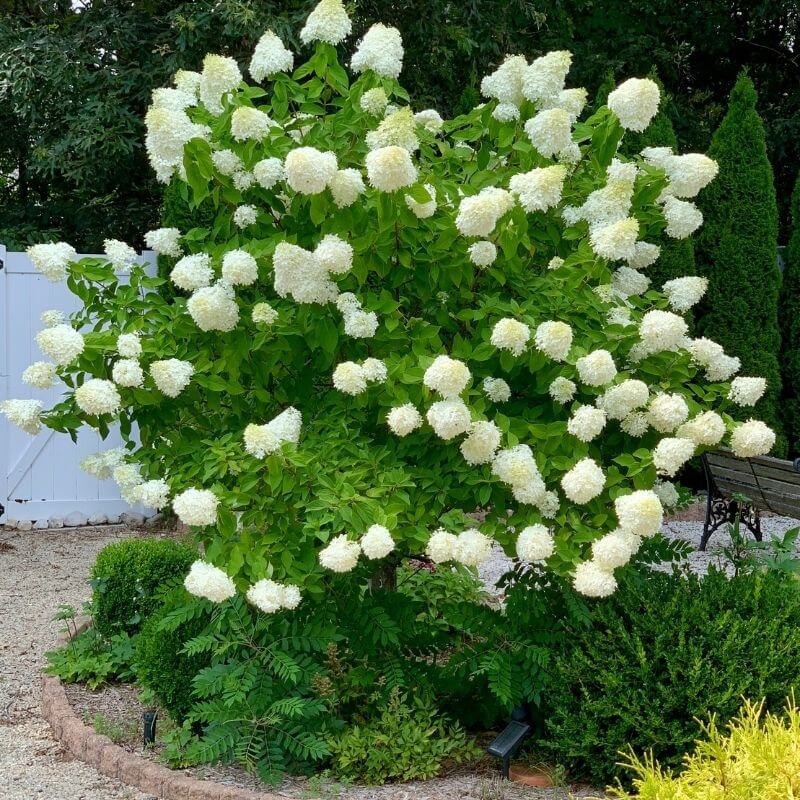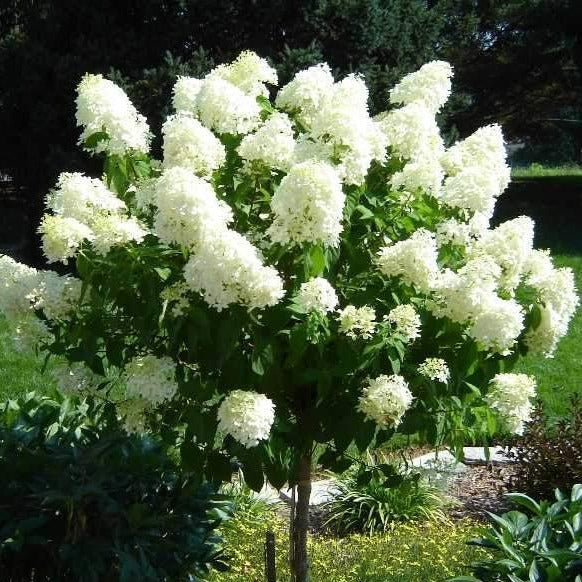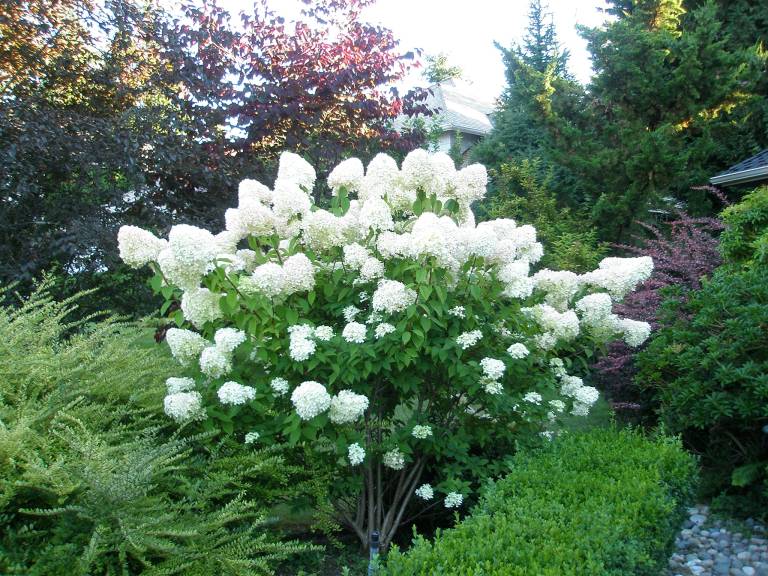Limelight Hydrangea Tree: How to Plant, Grow, and Care

What is Limelight Hydrangea Tree?
Limelight Hydrangea Tree is a beautiful and unique ornamental tree that has been gaining popularity in recent years. Unlike traditional hydrangea bushes, the Limelight Hydrangea Tree grows in the form of a small tree, reaching up to 6-8 feet in height and width. The tree’s most distinctive feature is its large, cone-shaped flowers that bloom in mid-summer and last until early fall. The flowers start off as a bright lime green color and gradually turn pink and burgundy as the season progresses, creating a stunning ombré effect.
One of the most noteworthy aspects of the Limelight Hydrangea Tree is its hardiness. It is a deciduous tree that can survive in a variety of soil types and pH levels, making it adaptable to many different environments. It is also drought-tolerant and able to withstand extreme heat and cold temperatures, making it an ideal choice for gardeners in a variety of climates.
Another benefit of the Limelight Hydrangea Tree is its low maintenance requirements. Unlike many other flowering trees, the Limelight Hydrangea Tree does not require regular pruning or shaping to maintain its form. It is also relatively disease-resistant and pest-free, making it a worry-free addition to any garden or landscape.
Finally, the Limelight Hydrangea Tree is a great choice for those looking to attract pollinators to their garden. The tree’s large, showy flowers are a favorite among bees, butterflies, and other beneficial insects, helping to support the local ecosystem and promote biodiversity.
Overall, the Limelight Hydrangea Tree is an excellent choice for those looking to add a unique and stunning ornamental tree to their landscape. With its hardy nature, low maintenance requirements, and ability to attract pollinators, this tree is sure to be a standout in any garden or outdoor space.
Fast Facts About Limelight Hydrangea Tree
| Origin | North America |
|---|---|
| Common Name | Limelight Hydrangea Tree |
| Botanical Name | Hydrangea paniculata ‘Limelight’ |
| Family | Hydrangeaceae |
| Plant Type | Deciduous shrub |
| Genus | Hydrangea |
| Mature Height | 6-8 feet |
| Mature Width | 6-8 feet |
| Sun Exposure | Full sun to part shade |
| Soil Type | Well-draining soil |
| Soil pH | 5.0-6.2 |
| Soil Drainage | Moist but well-drained |
| Bloom Time | Mid-summer to early fall |
| Attracts | Bees, butterflies, and other beneficial insects |
| Maintenance | Low maintenance |
| Water Needs | Moderate |
| Native Area | Asia and North America |
| Drought Tolerance | Drought tolerant once established |
| Characteristics | Large, cone-shaped flowers that bloom in a lime green color and gradually turn pink and burgundy |
| Suggested Use | Hedge, border, specimen, or accent plant |
| USDA Hardiness Zone | 3-8 |

How to Plant and Grow Limelight Hydrangea Tree
Selecting the Right Location
When selecting a location to plant your Limelight Hydrangea Tree, it is important to choose a spot that receives full morning sunlight and partial shade for the rest of the day. The tree prefers moist, well-drained, fertile soil and can grow in full sun to part shade. It is recommended to provide some afternoon shade in hot climates to avoid stressing the plant. When planning your space, keep in mind the size of the tree and give it enough room to grow.
Preparing for Planting
Once you have selected the right location, it’s time to prepare for planting. Dig a hole that is twice as wide and deep as the root ball. Add compost or other organic matter to the soil to improve drainage and nutrient content. Place the tree in the hole and backfill with soil, gently packing it down to remove air pockets. Water the tree deeply after planting, and continue to water it regularly until it is established.
Caring for the Tree
As your Limelight Hydrangea Tree grows, there are a few things to keep in mind to ensure its health and vitality. Common pests and diseases include aphids, spider mites, and leaf spot. To address these issues, you can use insecticidal soap or neem oil, and prune infected branches to prevent the spread of disease. Prune your tree in late winter or early spring to maintain its shape and encourage new growth.
Maintenance
To keep your Limelight Hydrangea Tree healthy and growing strong, make sure to water it regularly during dry periods, especially during the first growing season. Fertilize the tree in the spring with a balanced fertilizer, and apply a layer of mulch around the base of the tree to help retain moisture and suppress weeds. Protect the tree from harsh weather conditions such as frost and wind, and adjust the watering and fertilizing schedule depending on the time of year.
What are the Common Problems with Limelight Hydrangeas
- Crowding out other plants: A common problem with Limelight Hydrangeas is that they take a few years to get going, but once they do, they can crowd out other plants in the garden.
- Too much sun or shade: These plants require a balance of both sun and shade to thrive. Too much or too little of either can lead to problems with growth and overall health.
- Watering incorrectly: Watering Limelight Hydrangeas incorrectly, whether too much or too little, can cause stress and lead to wilting or leaf drop.
- Poor drainage: These plants prefer moist, well-drained soil and can suffer if planted in soil that is poorly drained.
- Overcrowding: If Limelight Hydrangeas are placed too close together, it can lead to problems with air circulation, which can make the plants more susceptible to pests and diseases.
- Fungal infections: Two types of fungal diseases can infect hydrangeas, including cercospora leaf spot and anthracnose, which can cause problems with the leaves.
- Pests: Common pests like aphids and spider mites can also affect the health of these plants if left untreated.
- Wilting: Wilting of leaves is common with hydrangeas, especially when temperatures rise above 85F. Lack of a large root system can contribute to this problem.
- Fertilizer burn: Over-application or applying fertilizer to a thirsty plant can lead to fertilizer burn, causing damage to the plant.
- Small flowers: Too little sunlight, incorrect fertilizer, or incorrect amount of water can cause problems with the size of Limelight Hydrangea flowers.
How Much Water Does a Limelight Hydrangea Tree Need?
Limelight Hydrangea Trees require moderate watering once established. Water your tree thoroughly and deeply, allowing the soil to dry slightly before watering again. After the first growing season, plants should only be watered during extended periods without rain.
It is recommended to water your Limelight Hydrangea Tree once a week up to every 10 days in normal conditions. However, it’s important not to over-water, as this can cause stress on the plant. Once the tree has become established, it will need less water than when it was first planted.
How to Know if You Have Overwatered
Some of the common signs of overwatering include poor drainage around the base of the plant, brown edges on the leaves, leaf drop, mold or fungus in soil or on the plant, yellowing of leaves, and wilting.
It’s important to check the soil moisture levels regularly and ensure that the tree is not sitting in standing water. If you suspect overwatering, adjust your watering schedule accordingly and consider improving drainage around the plant’s base.
Interesting Landscape Ideas for Limelight Hydrangeas
| Landscape Idea | Description |
|---|---|
| Limelight Hedge: | Planting Limelight Hydrangeas in a row is a great way to create a natural hedge. Limelight’s large blooms and lovely foliage make it an ideal plant for this purpose. |
| Mixed Border: | Plant Limelight Hydrangeas in a mixed border with other plants such as roses, hostas, and ornamental grasses. This creates a beautiful and diverse landscape that is both eye-catching and low-maintenance. |
| Foundation Planting: | Limelight Hydrangeas make an excellent foundation planting around the house or along the driveway. Their upright growth habit and large blooms add a lovely touch to any landscape design. |
| Patio Container: | Planting Limelight Hydrangeas in a large patio container is a great way to incorporate these beautiful plants into your outdoor living space. This is especially useful if you have limited garden space. |
| Tree Form: | Limelight Hydrangeas can be trained to grow in a tree form, which makes a stunning focal point in any landscape. These trees can be pruned to maintain their shape and size and can even be used to create a shady spot in your garden. |
| Mass Planting: | Mass planting Limelight Hydrangeas is an excellent way to create a bold statement in your landscape. This technique works particularly well in large gardens or commercial spaces. |
| Woodland Garden: | Incorporating Limelight Hydrangeas into a woodland garden provides a beautiful contrast to the natural landscape. Plant them amongst a variety of shade-loving plants and trees. |
| Mixed Hydrangea Bed: | Create a mixed hydrangea bed by planting Limelight hydrangeas alongside other hydrangea varieties. This creates a beautiful and varied display of hydrangea blooms in your garden. |

What Does Limelight Hydrangea Tree Symbolize?
| Symbolism | Description |
|---|---|
| Renewal and Rebirth | The Limelight Hydrangea tree represents new beginnings and fresh starts, making it a popular choice for weddings and other celebrations. |
| Longevity and Endurance | The tree’s hardiness and ability to thrive in a variety of conditions symbolize longevity and endurance, representing strength and resilience. |
| Perseverance | The Limelight Hydrangea tree’s ability to bloom even in adverse conditions, such as drought or extreme temperatures, is a symbol of perseverance and determination. |
| Serenity and Tranquility | With its soft, delicate blooms and calming color palette, the Limelight Hydrangea tree represents serenity, peace, and tranquility. |
| Hope and Optimism | The vibrant green color of the tree’s blooms symbolizes growth, renewal, and hope, while the changing color of the flowers from lime green to white or pink represents new possibilities and opportunities. |
| Abundance and Prosperity | The Limelight Hydrangea tree’s abundant blooms represent wealth, prosperity, and abundance, making it a popular choice for gardens and landscapes. |
| Gratitude and Thankfulness | The tree’s beauty and resilience evoke feelings of gratitude and thankfulness, reminding us to appreciate the simple things in life. |
| Grace and Elegance | The Limelight Hydrangea tree’s graceful and elegant appearance makes it a popular choice for formal gardens, weddings, and other upscale events. |
| Admiration and Respect | The tree’s beauty and hardiness inspire admiration and respect, making it a symbol of honor, dignity, and reverence. |
| Protection and Care | The Limelight Hydrangea tree’s ability to provide shade, shelter, and protection for wildlife and other plants represents care, nurturing, and stewardship. |

The Pros and Cons of Limelight Hydrangeas
Advantages:
- Showy blooms: One of the biggest advantages of Limelight Hydrangeas is their large, showy blooms. These blooms last from mid-summer through fall and make a bold statement in any landscape design.
- Easy to grow: Limelight Hydrangeas are generally easy to grow and require minimal maintenance once established. They are tolerant of many soil types and can handle both full sun and partial shade.
- Versatile: Limelight Hydrangeas can be used in a variety of landscape designs, including hedges, mixed borders, foundation plantings, and patio containers. They can also be trained to grow in a tree form, which adds another dimension to their versatility.
- Long-lasting Blooms: Limelight Hydrangeas’ flowers gradually turn pink in the fall, adding interest to the garden.
- Drought-tolerant: Once established, Limelight Hydrangeas are drought-tolerant and do not require frequent watering.
Disadvantages:
- Late bloomers: Limelight Hydrangeas take longer than most hydrangeas to start blooming, typically blooming in mid to late summer.
- Large size: While their large growth habit makes them ideal for hedges or as a focal point in the landscape, they may not be suitable for smaller gardens or container gardening.
- Can flop: Due to the weight of their large blooms, Limelight Hydrangeas can sometimes flop over, especially after heavy rain. Staking or pruning may be necessary to prevent this.
- Winter protection: In colder climates, Limelight Hydrangeas may require winter protection such as mulching or burlap wrapping to protect their tender branches from frost damage.
- Potential pest problems: While Limelight Hydrangeas are generally pest-resistant, they can sometimes fall prey to aphids, spider mites, or powdery mildew. Regular monitoring and treatment may be necessary to prevent widespread infestation.
7 Best Limelight Hydrangeas Alternatives
| Hydrangea Variety | Bloom Time | Flower Type | Flower Color | Plant Height | Plant Width | USDA Hardiness Zones |
|---|---|---|---|---|---|---|
| Annabelle Hydrangea | Late Spring to Early Summer | Large, Round, Fuzzy Blooms | White | 3-5 feet | 3-5 feet | 3-9 |
| Pinky Winky Hydrangea | Mid to Late Summer | Cone-shaped Blooms | White and Pink | 6-8 feet | 6-8 feet | 3-8 |
| Incrediball Hydrangea | Late Spring to Early Summer | Large, Round Blooms | White | 4-5 feet | 4-5 feet | 3-9 |
| Little Lime Hydrangea | Mid-Summer to Fall | Cone-shaped Blooms | White and Green | 3-5 feet | 3-5 feet | 3-8 |
| Tuff Stuff Ah-Ha Hydrangea | Early to Mid-Summer | Lacecap Blooms | Pink or Blue | 2-3 feet | 3-4 feet | 5-9 |
| Endless Summer Hydrangea | Mid-Summer to Fall | Mophead or Lacecap Blooms | Pink or Blue | 3-5 feet | 3-5 feet | 4-9 |
| Limelight Prime Hydrangea | Mid-Summer to Fall | Panicle Blooms | Green and White | 6-8 feet | 6-8 feet | 3-8 |
Frequently Asked Questions
1. Do Limelight Hydrangeas Smell Good?
Yes, Limelight Hydrangea blooms are known to be fragrant and sweet-smelling. The scent is often compared to jasmine or floral, and occasionally a fruity scent.
2. Should I Deadhead Limelight Hydrangeas?
Deadheading is the process of removing spent blooms to encourage new growth and prolong the blooming period. While deadheading is not necessary for the health of the plant, it can help keep your Limelight Hydrangeas looking neat and tidy. If you prefer a more natural look, you can skip deadheading and let the blooms fade and dry on the plant. However, if you want to encourage more blooms and a longer blooming period, deadheading may be worth considering. Ultimately, the decision to deadhead your Limelight Hydrangeas is up to you and your personal preferences.
3. Can I Change the Color of Limelight Hydrangeas?
The color of Limelight Hydrangeas cannot be changed by traditional methods such as adding fertilizer or changing soil pH. However, it’s possible for the blooms to change color naturally as they mature and age. When Limelight Hydrangea blooms first appear in mid to late summer, they are typically a vibrant lime green color. As the blooms mature, they may turn to a creamy white or even pink hue. Additionally, the color of Limelight Hydrangea blooms can be altered through a process known as cut flower color manipulation. This involves cutting the blooms at a specific time and then placing them in a solution that contains a special dye. The dye is absorbed by the petals, resulting in flowers with a different color than their natural hue. However, this process is typically performed by professional florists and is not recommended for home gardeners.
Also read:
- Golden Mop Cypress: How to Plant, Grow, and Care
- Snowball Bush: How to Plant, Grow, and Care
- Liriope: How to Plant, Grow, and Care
- Needlepoint Holly: How to Plant, Grow, and Care
- Firepower Nandina: How to Plant, Grow, and Care
- Hicks Yew Hedge: How to Plant, Grow, and Care
- Rose Creek Abelia: The Compact Evergreen Charm





